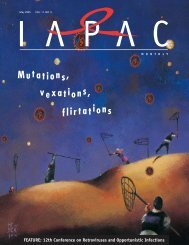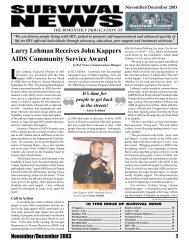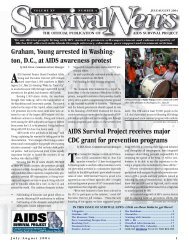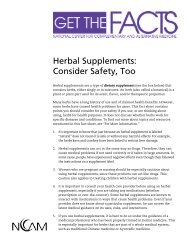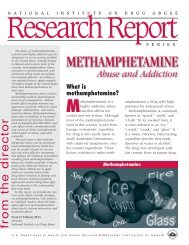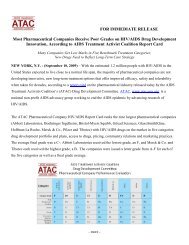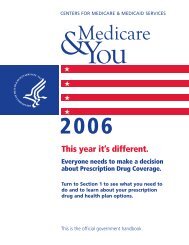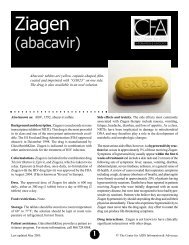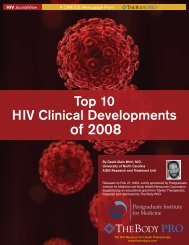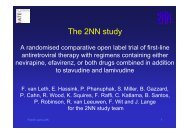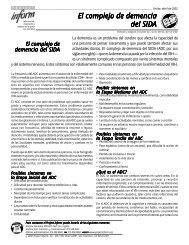Mental Health Aids. Spring 2011. - Substance Abuse and Mental ...
Mental Health Aids. Spring 2011. - Substance Abuse and Mental ...
Mental Health Aids. Spring 2011. - Substance Abuse and Mental ...
Create successful ePaper yourself
Turn your PDF publications into a flip-book with our unique Google optimized e-Paper software.
model. 1<br />
1 The purpose was (a) to iden-<br />
__________ tify strategies influencing participant<br />
Otto-Salaj <strong>and</strong> colleagues (2008) describe<br />
the Power/Interaction Model of Interpersonal<br />
Influence (Raven, 1992) as follows: “Raven proposes<br />
six bases of power from which people<br />
derive strategies attempting to influence the<br />
behavior of others: (a) reward; (b) coercion;<br />
(c) legitimate; (d) expert; (e) referent; <strong>and</strong><br />
(f) information. According to Raven, coercive<br />
<strong>and</strong> reward power can refer to real physical<br />
threats <strong>and</strong> tangible rewards, but they also<br />
can include personal rejection or approval. Legitimate<br />
power is derived from the structural<br />
gram implementation in even resource-poor<br />
community settings.<br />
Further, the National Institutes of<br />
<strong>Health</strong>, the CDC, <strong>and</strong> a variety of<br />
private funding agencies emphasize<br />
“technology transfer” or “capacity<br />
building” as core funding areas.<br />
(p. 960)<br />
McKirnan <strong>and</strong> colleagues add that they<br />
attempted to integrate a treatment<br />
advocate session with each primary<br />
care visit[, but] . . . found this approach<br />
to take substantial clinic cooperation,<br />
<strong>and</strong> many men had<br />
moved toward a biannual or even<br />
annual primary care visit schedule,<br />
which may be too sparse for HIV<br />
prevention needs. As a consequence,<br />
most follow-up visits were<br />
“free-st<strong>and</strong>ing” rather than part of a<br />
primary care visit, <strong>and</strong> [the investigators]<br />
could not test the efficacy of<br />
true integration of prevention into<br />
primary care. Although primary care<br />
is an important venue for prevention,<br />
community recruitment <strong>and</strong> followup<br />
may be important adjuncts for<br />
broader scale secondary prevention.<br />
(p. 960)<br />
Although the investigators appropriately<br />
point up “limitations both to [the] findings<br />
<strong>and</strong>, potentially, to this intervention<br />
approach” (p. 960), they conclude that<br />
“TAP reduced transmission risk among<br />
HIV-positive MSM, although results are<br />
modest. Many participants <strong>and</strong> peer<br />
advocates commented favorably on the<br />
computer structure of the program.<br />
[McKirnan <strong>and</strong> colleagues] feel that<br />
the key elements of TAP – computerbased<br />
<strong>and</strong> individually tailored session<br />
content, delivered by peers, in the primary<br />
care setting – warrant further exploration”<br />
(p. 952).<br />
acquiescence to request <strong>and</strong> (b) to<br />
identify predictors of participant<br />
compliance/refusal to comply with<br />
negotiation attempts” (p. 539). In this<br />
study,<br />
__________<br />
relationship between the influencing agent <strong>and</strong><br />
the target; the agent may implicitly or explicitly<br />
communicate that she or he has a ‘right’<br />
to ask the target to engage in some behavior,<br />
<strong>and</strong> that the target has an obligation to comply.<br />
Expert power is acting on the assumption<br />
that the power-holder is ‘correct,’ while referent<br />
power refers to engaging in a behavior<br />
References<br />
Abdool Karim, Q., Abdool Karim, S.S.,<br />
Frohlich, J.A., Grobler, A.C., Baxter, C.,<br />
Mansoor, L.E., Kharsany, A.B., Sibeko, S.,<br />
Mlisana, K.P., Omar, Z., Gengiah, T.N.,<br />
Maarschalk, S., Arulappan, N., Mlotshwa,<br />
M., Morris, L., & Taylor D. (2010). Effectiveness<br />
<strong>and</strong> safety of tenofovir gel, an antiretroviral<br />
microbicide, for the prevention of<br />
HIV infection in women. Science, 329(5996),<br />
1168-1174.<br />
Dilley, J.W., Woods, W.J., Loeb, L., Nelson,<br />
K., Sheon, N., Mullan, J., Adler, B., Chen,<br />
S., & McFarl<strong>and</strong>, W. (2007). Brief cognitive<br />
counseling with HIV testing to reduce<br />
sexual risk among men who have sex with<br />
men: Results from a r<strong>and</strong>omized controlled<br />
trial using paraprofessional counselors.<br />
Journal of Acquired Immune Deficiency<br />
Syndromes, 44(5), 569-577.<br />
Grant, R.M., Lama, J.R., Anderson, P.L.,<br />
McMahan, V., Liu, A.Y., Vargas, L.,<br />
Goicochea, P., Casapía, M., Guanira-Carranza,<br />
J.V., Ramirez-Cardich, M.E., Montoya-Herrera,<br />
O., Fernández, T., Veloso,<br />
V.G., Buchbinder, S.P., Chariyalertsak, S.,<br />
Schechter, M., Bekker, L.-G., Mayer, K.H.,<br />
Kallás, E.G., Amico, K.R., Mulligan, K.,<br />
Bushman, L.R., Hance, R.J., Ganoza, C.,<br />
Defechereux, P., Postle, B., Wang, F.,<br />
McConnell, J.J., Zheng, J.-H., Lee, J.,<br />
Rooney, J.F., Jaffe, H.S., Martinez, A.I.,<br />
Burns, D.N., & Glidden, D.V. (2010).<br />
Preexposure chemoprophylaxis for HIV<br />
prevention in men who have sex with men.<br />
New Engl<strong>and</strong> Journal of Medicine, 363(27),<br />
2587-2599.<br />
Hankins, C.A., & de Zalduondo, B.O. (2010).<br />
Combination prevention: A deeper underst<strong>and</strong>ing<br />
of effective HIV prevention. AIDS,<br />
24(Suppl. 4), S70-S80.<br />
Hayes, R., Kapiga, S., Padian, N.,<br />
McCormack, S., & Wasserheit, J. (2010).<br />
HIV prevention research: Taking stock <strong>and</strong><br />
the way forward. AIDS, 24(Suppl. 4), S81-<br />
S92.<br />
McKirnan, D.J., Tolou-Shams, M., &<br />
Courtenay-Quirk, C. (2010). The Treatment<br />
Advocacy Program: A r<strong>and</strong>omized controlled<br />
trial of a peer-led safer sex intervention for<br />
HIV-infected men who have sex with men.<br />
Journal of Consulting & Clinical Psychol-<br />
participants viewed six videotape<br />
segments showing an actress,<br />
portrayed in silhouette, speaking<br />
to the viewer as a “steady partner.”<br />
After each segment, participants<br />
completed measures of<br />
request compliance, positive <strong>and</strong><br />
__________<br />
because of a sense of connection or relationship<br />
with the influencing agent. Finally, informational<br />
power is based on the logical argument<br />
that the influencing agent can present,<br />
either directly or indirectly, to the target in order<br />
to implement change” (p. 152).<br />
ogy, 78(6), 952-963.<br />
Michael, N.L. (2010). Oral preexposure prophylaxis<br />
for HIV – Another arrow in the<br />
quiver? [Editorial]. New Engl<strong>and</strong> Journal of<br />
Medicine, 363(27), 2663-2665.<br />
Naar-King, S., Outlaw, A., Green-Jones, M.,<br />
Wright, K., & Parsons, J.T. (2009). Motivational<br />
interviewing by peer outreach<br />
workers: A pilot r<strong>and</strong>omized clinical trial<br />
to retain adolescents <strong>and</strong> young adults in<br />
HIV care. AIDS Care, 21(7), 868-873.<br />
Patel, V., Weiss, H.A., Chowdhary, N., Naik,<br />
S., Pednekar, S., Chatterjee, S., De Silva,<br />
M.J., Bhat, B., Araya, R., King, M., Simon,<br />
G., Verdeli, H., & Kirkwood, B.R. (2010).<br />
Effectiveness of an intervention led by lay<br />
health counsellors for depressive <strong>and</strong> anxiety<br />
disorders in primary care in Goa, India<br />
(MANAS): A cluster r<strong>and</strong>omised controlled<br />
trial. Lancet, 376(9758), 2086-2095.<br />
Raja, S., McKirnan, D., & Glick, N. (2007).<br />
The Treatment Advocacy Program-Sinai:<br />
A peer-based HIV prevention intervention<br />
for working with African American HIVinfected<br />
persons. AIDS & Behavior, 11<br />
(Suppl. 1), 127-137.<br />
Relf, M.V., Mekwa, J., Chasokela, C.,<br />
Nhlengethwa, W., Letsie, E., Mtengezo,<br />
J., Ramantele, K., Diesel, T., Booth, C.,<br />
Deng, L., Mallinson, R.K., Powell, D.,<br />
Webb, A., Liddle, A., Yu-Shears, J., Hall,<br />
C., Ar<strong>and</strong>a-Naranjo, B., & Hopson, D.P.<br />
(2011). Essential nursing competencies<br />
related to HIV <strong>and</strong> AIDS. Journal of the<br />
Association of Nurses in AIDS Care, 22<br />
(1 Suppl. 1), e5-e40.<br />
Ross, D.A. (2010). Behavioural interventions<br />
to reduce HIV risk: What works? AIDS,<br />
24(Suppl. 4), S4-S14.<br />
Selke, H.M., Kimaiyo, S., Sidle, J.E.,<br />
Vedanthan, R., Tierney, W.M., Shen, C.,<br />
Denski, C.D., Katschke, A.R., & Wools-<br />
Kaloustian, K. (2010). Task-shifting of<br />
antiretroviral delivery from health care workers<br />
to persons living with HIV/AIDS: Clinical<br />
outcomes of a community-based<br />
program in Kenya. Journal of Acquired<br />
Immune Deficiency Syndromes, 55(4),<br />
483-490.<br />
—— Compiled by<br />
Abraham Feingold, Psy.D.<br />
mental health AIDS, Volume 12(3), <strong>Spring</strong> 2011-------------------------------------------Page 7



